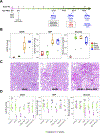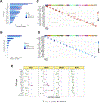Mapping the single-cell transcriptomic response of murine diabetic kidney disease to therapies
- PMID: 35709763
- PMCID: PMC9262852
- DOI: 10.1016/j.cmet.2022.05.010
Mapping the single-cell transcriptomic response of murine diabetic kidney disease to therapies
Abstract
Diabetic kidney disease (DKD) occurs in ∼40% of patients with diabetes and causes kidney failure, cardiovascular disease, and premature death. We analyzed the response of a murine DKD model to five treatment regimens using single-cell RNA sequencing (scRNA-seq). Our atlas of ∼1 million cells revealed a heterogeneous response of all kidney cell types both to DKD and its treatment. Both monotherapy and combination therapies targeted differing cell types and induced distinct and non-overlapping transcriptional changes. The early effects of sodium-glucose cotransporter-2 inhibitors (SGLT2i) on the S1 segment of the proximal tubule suggest that this drug class induces fasting mimicry and hypoxia responses. Diabetes downregulated the spliceosome regulator serine/arginine-rich splicing factor 7 (Srsf7) in proximal tubule that was specifically rescued by SGLT2i. In vitro proximal tubule knockdown of Srsf7 induced a pro-inflammatory phenotype, implicating alternative splicing as a driver of DKD and suggesting SGLT2i regulation of proximal tubule alternative splicing as a potential mechanism of action for this drug class.
Keywords: ACEi; FSGS; SGLT2i; T2D; chronic kidney disease; diabetes; drug response; hypertension; kidney; rosiglitazone; single-cell RNA-seq.
Copyright © 2022 The Author(s). Published by Elsevier Inc. All rights reserved.
Conflict of interest statement
Declaration of interests R.G.V., X.Y., D.R., T.C., M.R., C.M., E.M., and M.D.B. are employees of Janssen Research & Development, LLC. M.D.B. holds Johnson and Johnson stock. B.D.H. is a consultant for Janssen Research & Development, LLC, Pfizer, and Chinook Therapeutics. B.D.H. holds equity in Chinook Therapeutics.
Figures







References
-
- Alexa A, Rahnenführer J, and Lengauer T (2006). Improved scoring of functional groups from gene expression data by decorrelating GO graph structure. Bioinformatics 22, 1600–1607. - PubMed
Publication types
MeSH terms
Substances
Grants and funding
LinkOut - more resources
Full Text Sources
Other Literature Sources
Medical
Molecular Biology Databases

